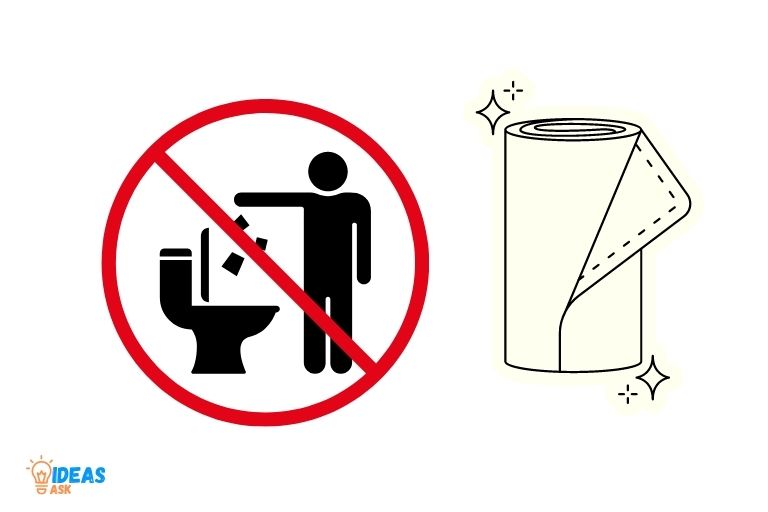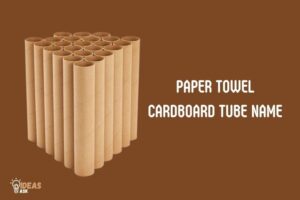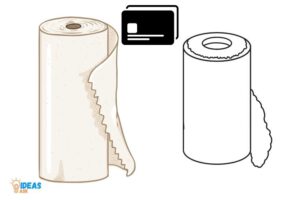Do Not Flush Paper Towels Sign! Reasons & Essential role
Do not flush paper towels sign is a clear and informative notice displayed in restrooms to prevent the disposal of paper towels in toilets, as they can cause severe blockages and plumbing issues.
These signs play an essential role in maintaining the proper functioning of a building’s plumbing system. Paper towels are significantly thicker and more durable than toilet paper, which is designed to break down quickly in water.
When people flush paper towels, they can accumulate, leading to clogged pipes and potential water damage.
Do not flush paper towels sign should be placed in a highly visible location inside restrooms, near the sinks or toilets, to ensure users are aware of the proper disposal method.
By following these guidelines, restroom users can contribute to maintaining a functional and efficient plumbing system while preventing costly repairs and potential water damage.
Reasons to Avoid Flushing Paper Towels
| Do Not Flush | Items to Avoid | Reason |
|---|---|---|
| Paper Towels | 1. They do not dissolve easily | |
| 2. Can cause clogs and backups in plumbing system | ||
| 3. May lead to damage to sewer lines and costly repairs | ||
| Alternative Options | ||
| 1. Trash Can | Dispose of paper towels and any other non-flushable items in a nearby trash can to prevent plumbing issues | |
| 2. Hand Dryers | Use available hand dryers to reduce paper towel usage and minimize waste |
Key Takeaway

Five Facts About Not Flushing Paper Towels
The Problem With Flushing Paper Towels
While it may seem convenient to flush paper towels down the toilet, it actually causes a lot of issues. Here are some reasons why flushing paper towels is a big problem:
Explanation Of How Paper Towels Are Not Biodegradable Like Toilet Paper
- Unlike toilet paper, paper towels are not designed to break down easily when exposed to water. This is because they are made from thicker, more durable fibers that are meant to withstand cleaning and scrubbing.
- Paper towels can take weeks or even months to decompose when they end up in sewage systems or wastewater treatment plants. This adds to the already overloaded waste stream and can potentially harm the environment.
Discussion Of How Paper Towels Can Cause Clogs And Damage To Plumbing Systems
- Flushing paper towels can cause stubborn clogs in pipes and sewer lines. As they travel through the plumbing system, they can get caught on rough surfaces, such as tree roots or buildup of grease.
- These blockages not only cause an inconvenience for homeowners but can also lead to significant damage to the plumbing system. This could result in costly repairs, which could have been otherwise avoided.
Overview Of How Flushing Paper Towels Can Be Costly For Homeowners And Municipalities Alike
- The cost of having to repeatedly call a plumber to unclog pipes could add up quickly for homeowners. In addition to this, damaged pipes could also require more expensive repairs.
- Not only is the cost of repairs a major concern, but the cost of maintenance to municipalities can also be significant. When public sewer systems are clogged or damaged, it can mean expensive repairs and reduced capacity. This means the community could also suffer from the decrease in available facilities.
It’s important to properly dispose of paper towels in the trash can and not flush them down the toilet. Doing so can avoid potential environmental damage, plumbing issues and maintenance costs.
Importance Of Installing A “Do Not Flush Paper Towels” Sign
In recent years, the issue of clogged pipes due to flushing non-biodegradable materials has become a major cause of concern for many homeowners and businesses.
Flushing paper towels is one of the leading culprits. To prevent these issues, it’s vital to install “do not flush paper towels” signs in your bathrooms.
Provide Examples Of How “Do Not Flush Paper Towels” Signs Can Prevent Clogs And Costly Plumbing Repairs
A “do not flush paper towels” sign can help prevent clogs and expensive plumbing repairs in several ways:
- Oftentimes, people are unaware that flushing paper towels can lead to clogs and other plumbing issues. A sign can serve as a clear reminder to dispose of paper towels properly and avoid flushing them down the toilet.
- By creating awareness, people who may have previously flushed paper towels down the toilet will think twice before doing so and will dispose of their paper towels in the proper way.
- If signs are promptly installed, it will ensure that tenants, visitors, and employees alike become more conscious about flushing inappropriate materials down the toilet.
Discuss The Role Of Education And Awareness In Preventing The Flushing Of Non-Biodegradable Materials
Education and awareness are vital when it comes to preventing the flushing of non-biodegradable materials. People often do not realize the impact flushing non-biodegradable materials can have on the environment, the plumbing, and sewage systems.
A “do not flush paper towels” sign can serve as an effective visual reminder that waste needs to be disposed of in the correct way. Installing these signs provides an opportunity to educate people on the importance of not flushing paper towels and the implications of doing so.
This can be done through the use of clear and concise messaging, using phrases such as “help protect the environment” and “avoid costly plumbing repairs. “
By spreading awareness about the damaging effects of flushing paper towels down the toilet, people will be more inclined to protect this precious resource and avoid causing unpleasant and costly damage to their plumbing system.
Highlight The Benefits Of Using A Visual Reminder To Encourage Responsible Disposal
A visual reminder in the form of a “do not flush paper towels” sign is an effective way of discouraging the unintended disposal of paper towels in the toilet.
Benefits of using visuals to encourage responsible disposal include:
- Accessibility: A visual message is accessible to all, regardless of language, age, or background. This helps to spread the message more widely to people from different parts of the world or with varying literacy levels.
- Cost-effectiveness: “do not flush paper towels” signs are an inexpensive and simple way of encouraging responsible disposal of waste. Investing in these small signs will eventually help save money by stopping the flushing of materials that damage plumbing systems.
- Reducing environmental impact: The use of “do not flush paper towels” signs encourages responsible disposal of waste, reducing hazardous waste that pollutes waterways and nature.
Installing “do not flush paper towels” signs is essential to prevent blockages and damage to your plumbing systems. A visual reminder can create awareness and encourage people to dispose of their waste material properly.
So, do your part in protecting your plumbing systems and the environment by installing a “do not flush paper towels” sign today!
Factors To Consider When Choosing A “Do Not Flush Paper Towels” Sign
A “do not flush paper towels” sign is essential for any establishment with a washroom facility. It is a gentle, yet firm reminder to guests that paper towels should not be flushed down the toilet, as this could lead to clogging and damage to the sewer system.
Here are a few factors to consider when choosing the right sign for your washroom:
Overview Of Different Sign Materials And Durability
When it comes to the material of your “do not flush paper towels” sign, a few options are available. You can choose between metal, plastic, or laminated paper signs. Each material has its pros and cons in terms of durability, cost, and aesthetics.
Here are some details to help guide your decision:
- Metal: Durable and long-lasting, but can be expensive and may not match the decor of your washroom.
- Plastic: Affordable and lightweight, but not as durable as metal and may fade over time if exposed to sunlight.
- Laminated paper: Inexpensive and customizable, but not as durable as the other materials and may not withstand frequent handling.
Discussion Of Sizing And Placement Options For Optimal Visibility
When choosing the size and placement of your sign, it’s essential to consider its visibility and accessibility.
Here are a few tips to maximize the impact of your “do not flush paper towels” sign:
- Size: Choose a sign size that is neither too small nor too large. A sign that is too small may be overlooked, while a sign that is too large may appear obnoxious. An appropriate size for an “do not flush paper towels” sign is around 8.5 x 11 inches.
- Placement: Position the sign at eye level, preferably above the toilet or near the sink. Consider the flow of traffic in the restroom when deciding where to place the sign, ensuring that it’s easily noticeable.
Explanation Of Compliance With Local And State Regulations
Compliance with local and state regulations is essential when choosing a “do not flush paper towels” sign. Check with your local authorities regarding any specific requirements for the sign’s content, language, size, and placement.
Here are a few general guidelines to consider:
- Content: The sign should clearly state “do not flush paper towels” in bold letters for easy visibility.
- Language: Use simple, actionable language that conveys the message effectively.
- Size and placement: The sign should be large enough and strategically placed to ensure visibility and accessibility to all users.
Choosing the right “do not flush paper towels” sign is crucial to maintain the functionality of your washroom facility and avoid costly plumbing repairs. Consider the different materials, sizes, placements, and compliance requirements when selecting your sign.
Remember that an effective sign is one that is clearly visible, easily understood, and effectively conveys the message.
Best Practices For Implementing “Do Not Flush Paper Towels” Signage
Improper disposal of paper towels such as flushing them down the toilet can cause serious problems for sewage systems. Implementing a “do not flush paper towels” signage campaign can help prevent blockages, backups, and other issues.
Here are some of the best practices for implementing these signs:
Provide Recommendations For Educating Employees And Community Members About Responsible Disposal
To make sure that the community members and employees follow the signage campaign, consider implementing the following educational strategies:
- Conduct a training session to educate employees, especially those who handle maintenance and cleaning tasks, about the importance of proper paper towel disposal methods.
- Display educational posters in the restrooms, hallways, and common areas of your facility to discourage paper towel flushing. Make sure your signage is clear, to the point, and easy to read.
- Use social media and email communications to reach out to the community members, and make announcements about the signage campaign. Provide explanatory information and answer any questions that they may have.
Suggest Complementary Waste Disposal Options, Such As Trash Cans Or Compost Bins
For the safe disposal of paper towels, encourage alternative waste disposal options, including:
- Place trash cans in easily accessible areas of your facility, such as the restrooms, kitchens, and hallways. Signs should be displayed in and around the trash cans to clearly indicate that they are meant for paper towels.
- Consider compost bins for composting paper towel waste, or offer composting services through a professional company. This can significantly reduce your facility’s environmental footprint, and showcase sustainability in your business operations.
Discuss Maintenance And Upkeep Of Signs
To maintain the effectiveness and longevity of the signage campaign, make sure to:
- Regularly inspect your existing signs and replace them as required. Signs should be kept clean, legible, current, and in good condition.
- Seek feedback from employees and community members through surveys, suggestion boxes, and focus groups to make sure the signage is effective in message transmission and easy to understand.
- Review your signage content regularly to make sure it is up-to-date, comprehensive, and well-targeted to your audience.
With these guidelines, you can effectively implement a “do not flush paper towels” signage campaign in your facility and encourage responsible waste disposal practices among employees and customers.
FAQ About Not Flushing Paper Towels Sign
Why Shouldn’t Paper Towels Be Flushed?
Flushing paper towels can clog pipes, harm the sewage system, and damage the environment.
Can Paper Towels Be Flushed With Caution?
No, even if you flush paper towels carefully, they are not easily degradable and can cause blockages.
What Are Some Alternatives To Flushing Paper Towels?
Use a trash can, cloth towels, or toilet paper as alternatives to paper towels.
What Should You Do If You Accidentally Flush Paper Towels?
If you accidentally flush paper towels, contact a plumber immediately to prevent any clogs or pipe damage.
Conclusion
After reading this blog, it should be clear why it is crucial not to flush paper towels down the toilet. Doing so can cause significant plumbing problems, blockages, and costly repairs, as well as environmental harm. A “do not flush paper towels sign” can save your pipes and decrease your environmental footprint.
It is essential to remember that only toilet paper, human waste, and water should go down the toilet. Some alternatives to paper towels include washable fabric towels, cloth napkins, and reusable silicone food bags.
Implementing these alternatives can reduce your household’s contribution to environmental waste and save you money in the long run. The sign is a small but meaningful reminder that we all need to do our part in protecting our pipes and the environment. Remember, every little effort counts, and your actions can make a difference in the world.






